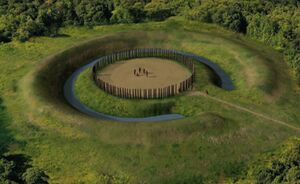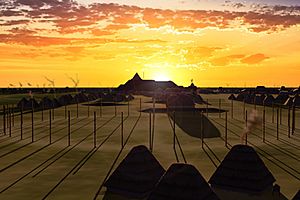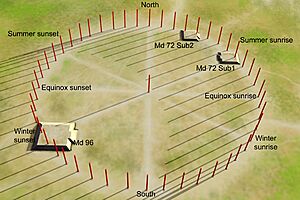Timber circle facts for kids
In archaeology, timber circles are ancient rings of upright wooden posts. People mainly built them in the British Isles and North America a long time ago. Today, we only find rings of holes where the posts once stood. These are different from palisades, which were walls. Like stone circles, people believe timber circles were used for special ceremonies, religious events, or to track the sun and stars.
Contents
Ancient Wooden Circles in the British Isles
Timber circles in the British Isles were built during the late Neolithic (New Stone Age) and early Bronze Age. The wooden posts themselves disappeared long ago. We find these sites by looking for the rings of post-holes where the posts once stood. Air photos and special ground surveys help us find more and more of these hidden circles. Sometimes, a trace of the old post is still found in the hole, which helps archaeologists.
These circles are usually more than 20 meters (about 65 feet) across, and some are up to 60 meters (about 200 feet) wide. The posts themselves were often more than 50 centimeters (about 20 inches) wide. Many circles have at least two rings or ovals of posts, but some have only one. Wider gaps between the posts might have been entrances. Builders would replace the posts as they rotted away. In some cases, people later used stone circles instead of wood.
You can find timber circles alone or near other ancient monuments. For example, they are found with henges, like at Woodhenge, or large henge enclosures, like at Durrington Walls. A few timber circles, like Seahenge and Arminghall in Norfolk, and the early parts of The Sanctuary in Wiltshire, were built by themselves.
Several early Bronze Age timber circles have also been found in Ireland. A huge timber circle, 250 meters (about 820 feet) wide, was built around a passage tomb on the Hill of Tara. Smaller wooden circles were built at places like Newgrange and Navan.
Timber circles in the British Isles were likely used for special rituals or ceremonies. Animal bones and household waste found at many sites suggest people lived there temporarily and had big feasts during certain times of the year. These circles were built on high ground, so they would have been easy to see. Some sites have single burials, but not enough to suggest they were mainly burial grounds.
Timber Circles in the United States
Wooden circles have a long history among Native American societies. They have been used for thousands of years and are still used today. Examples range from the 3,400-year-old Archaic period Poverty Point site in Louisiana to 2,000-year-old Hopewell tradition circles in Ohio. Even today, the Sun Dance performed by some Native American groups on the Great Plains uses wooden pole "corrals."
One of the first wooden circles seen by Europeans was drawn by artist John White in July 1585. He visited the Algonquian village of Secotan in North Carolina. White was an artist and mapmaker for the Roanoke Colony expedition, which was the first attempt by the British to settle in the Americas. White's drawings are the only pictures we have of the Native Americans seen by England's first settlers on the Atlantic coast. White's drawing and the writings of Thomas Harriot, who was with him, describe a big religious festival. It might have been the Green Corn ceremony, with people dancing at a timber circle. The posts of the circle had carved faces. Harriot wrote that many people came from nearby villages. He noted they were "attired in the most strange fashion they can devise havinge certayne marks on the backs to declare of what place they bee." He also said that "Three of the fayrest Virgins" danced around a central post in the middle of the timber circle.
Poverty Point: America's Oldest Wooden Circles
The oldest known timber circles in North America were found at Poverty Point in 2009. Archaeologists from the University of Louisiana at Monroe and Mississippi State University made the discovery. They found proof of many circular wooden post structures in the 37.5-acre plaza area. These circles ranged from 25 meters (82 feet) to 63 meters (206 feet) wide. They were built when the site was first settled around 2400 BCE. Today, a ring of concrete posts marks where one of these ancient circles once stood.
Adena Culture Timber Circles

Archaeologists have found postholes from several timber circles during digs at Adena culture sites. These sites, called causewayed ring ditches, are in the Bluegrass region of Kentucky and nearby parts of Ohio and West Virginia. A good example was found by archaeologist William S. Webb in 1939. He was digging at the Mount Horeb Site 1 in Fayette County, Kentucky. Webb found a circle of "paired-posts" inside the earthwork ring and ditch. This 14.8-meter (48.5-foot) circle was made of 62 sets of paired posts and 8 single posts.
Hopewell Culture Timber Circles
Other examples of timber circles have been found at Hopewell culture sites in Ohio. The Moorehead Circle was built about 2,000 years ago at the Fort Ancient Earthworks. Jarrod Burks discovered it in 2005 using magnetic surveys at the large hilltop enclosure near Lebanon, Ohio. This site has three circles, with the outer one being about 60 meters (200 feet) wide. Robert Riordan, an archaeology professor at Wright State University, leads the study of this site. He thinks about 200 wooden posts, 3 to 4.5 meters (10 to 15 feet) tall, were placed in the outer circle. Charcoal found at the site shows it was built between 40 BCE and 130 CE. Other charcoal pieces from burnt posts date to 250 to 420 CE, suggesting the circle was used for several centuries.
In September 2005, archaeologist Frank Cowan dug at a smaller circular enclosure at the Stubbs Earthworks in Warren County, Ohio. He found a timber circle 73 meters (240 feet) wide, made of 172 large posts. Carbon dating of charcoal from the post holes shows this structure was built between 200 and 300 CE.
Cahokia Woodhenges: Ancient Calendars
The discovery of several "woodhenges" at Cahokia happened in the early 1960s. Dr. Warren Wittry was doing "salvage archaeology" before a highway was built. Most of the site had village houses, but he also found some unusually shaped large post holes. They formed arcs of posts spaced evenly apart. Wittry thought these arcs could be full circles. He believed the site might have been a calendar for tracking events like solstices (longest and shortest days) and equinoxes (equal day and night). He started calling them "woodhenges," comparing them to similar structures in England.
More digs found proof of five timber circles in the area, now called Woodhenges I through V. Each one had a different size and number of posts. Because four of the circles overlap, archaeologists think they were built one after another. Each new one was generally larger and had 12 more posts than the last. A complete plan for what is known as Woodhenge III was found. A reconstruction of this circle was built in 1985, with posts placed in the original holes. The Illinois State Park system manages the Cahokia site. They host public sunrise observations during the spring and fall equinoxes and the winter and summer solstices. These events do not include ceremonies out of respect for Native American beliefs.
Archaeologist Marvin Fowler has suggested that the woodhenges also helped "align" construction projects. He thinks there might have been up to three more in other key spots around the city of Cahokia. At least one other possible circle at Cahokia has been suggested by Fowler. This location was found near Mounds 72 and 96, south of Monks Mound. Several post holes suggest a ceremonial area with a 125.6-meter (412-foot) wide circle and 48 posts. Archaeologists have dated at least one post to about 950 CE. Research shows that four posts were at the main compass points (north, south, east, west). The eastern and western posts marked the sunrise and sunset on the equinoxes. Four other posts marked the sunrise and sunset positions for the summer and winter solstices. This setup is almost the same as Woodhenge III, just 0.6 meters (2 feet) larger. The two mounds at this location and their directions match several of the solstice marking posts. The post closest to the later burial of the "Birdman" marked the summer solstice sunrise when the site was used. The early parts of the mounds were built around these posts, but the posts were removed later.
|






